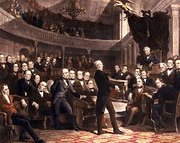Compromise of 1850
|
|

The Compromise of 1850, in the history of the United States, was a series of measures whose object was the settlement of five questions in dispute between the pro-slavery and anti-slavery factions in the United States. Three of these questions grew out of the annexation of Texas and the acquisition of western territory as a result of the Mexican-American War (1846–48). The settlers who had flocked to California after the discovery of gold in 1848 adopted an antislavery state constitution on the 13 October 1849, and applied for admission into the Union. In the second place it was necessary to form a territorial government for the remainder of the territory acquired from Mexico, including that now occupied by Nevada and Utah, and parts of Wyoming, Colorado, Arizona and New Mexico. The fundamental issue was in regard to the admission of slavery into, or the exclusion of slavery from, this region. Thirdly, there was a dispute over the western boundary of Texas: should the Rio Grande be the line of division north of Mexico, or should an arbitrary boundary be established farther north and eastward? In other words, should a considerable part of the new territory be certainly opened to slavery as a part of Texas, or possibly closed to it as a part of the organized territorial section? Underlying all of these issues was of course the great moral and political problem as to whether slavery was to be confined to the south-eastern section of the country or be permitted to spread to the Pacific. The two questions not growing out of the Mexican War were in regard to the abolition of the slave trade in the District of Columbia, and to the passage of a new fugitive slave law.
Congress met on December 3 1849. Neither faction was strong enough in both houses to carry out its own program, and it seemed for a time that nothing would be done. On January 29, 1850, Henry Clay presented the famous resolution which constituted the basis of the ultimate compromise. His idea was to combine the more conservative elements of both sections in favor of a settlement which would concede the Southern view on two questions, the Northern view on two, and balance the fifth. Former Vice President John C. Calhoun spoke on March 3 against the proposals. As he was near death, he had to be carried on and off of the floor by several senators, and the speech was read for him as he sat there. Calhoun died exactly four weeks later on March 31. Daniel Webster supported the plan in his great speech of March 7, although in doing so he alienated many of his former admirers. Opposed to the conservatives were the extremists of the North, led by William H. Seward and Salmon P. Chase, and those of the South, led by Jefferson Davis. Most of the measures were rejected and the whole plan seemed likely to fail, when the situation was changed by the death of President Taylor and the accession of Millard Fillmore on July 6, 1850. The influence of the administration was now thrown in favor of the compromise. Under a tacit understanding of the moderates to vote together, five separate bills were passed, and were signed by the president between September 9 and September 20 1850. Known as the "Great Debate", this debate included the three senators (Clay, Calhoun, and Webster) who are arguably the greatest orators in U.S. history.
The five separate bills
California was admitted as a free state, and the slave trade was abolished (only the sale of slaves, not slavery) in the District of Columbia; these were concessions to the North. New Mexico (then including present-day Arizona) and Utah were organized without any prohibition of slavery (each being left free to decide for or against, on admission to statehood), and the Fugitive Slave Act, requiring all U.S. citizens to assist in the return of runaway slaves, was enacted; these were concessions to the South. Texas was compelled to give up much of the western land to which it had a good claim, and received in return $10,000,000.
This legislation had several important results. It helped to postpone secession and Civil War for a decade, during which time the Northwest was growing more wealthy and more populous, and was being brought into closer relations with the Northeast. It divided the Whigs into "Cotton Whigs" and "Conscience Whigs", and in time led to the downfall of the party. In the third place, the rejection of the Wilmot Proviso and the acceptance (as regards New Mexico and Utah) of "Squatter Sovereignty" meant the adoption of a new principle in dealing with slavery in the territories, which, although it did not apply to the same territory, was antagonistic to the Missouri Compromise of 1820. The sequel was the repeal of the Missouri Compromise in the Kansas-Nebraska Act of 1854. Fourthly, the enforcement of the fugitive slave law aroused a feeling of bitterness in the North which helped eventually to bring on the war, and helped to make it, when it came, quite as much an anti-slavery crusade as a struggle for the preservation of the Union. The South, however, found this measure necessary, as it was a means to control the feelings of the North. Finally, although Clay for his support of the compromises and Seward and Chase for their opposition have gained in reputation, Webster has been selected as the special target for hostile criticism. The Compromise Measures are sometimes spoken of collectively as the Omnibus Bill, owing to their having been grouped originally—when first reported (May 8) to the Senate—into one bill.
